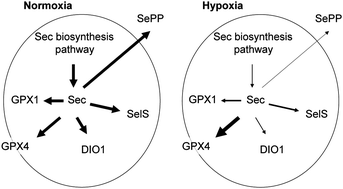Hypoxia lowers selenium metabolism
An important aspect of my investigation is how cellular hypoxia affects the metabolism of selenium. Some of you may have heard the recommendation to use sodium selenite instead of Selenomethionine.
Once I learned about the differences in the primary metabolism of different forms of selenium, it became obvious why selenite is preferred. Selenite is metabolized via a very short pathway (TXNRD), while Selenomethionine needs to escape the methionine cycle first and then go through the transsulfuration pathway to become selenocysteine. This journey is very long. There is one more enzyme at the final step, SCLY, that cleaves selenium from selenocysteine to make hydrogen selenide, the starting ingredient used to make pristine selenocysteine again.
I was interested in the regulation of that last step, SCLY, because my previous assumption that transsulfuration doesn’t work well was not supported by indirect lab measurements (namely slightly elevated cystathionine and slightly elevated 2-aminobutyric acid (R2), both of which point to CBS and CSE enzymes working very hard). And the fact that even small doses of selenite make significant improvements almost instantly caused me to think that something is not working well with Selenomethionine processing.
It turns out that SCLY is significantly downregulated in hypoxic conditions. This means that recycling of selenium from degraded proteins and from selenocysteine will not work efficiently. This also means that selenocysteine, transported via the SEPP1 protein from the liver to all tissues, will not be claimed by brain cells in hypoxia.

That’s actually a very important aspect to understand. Selenite overcomes all of this because it’s taken up and metabolized directly by the cells. They only need working Thioredoxin Reductase and NADPH.
One problem with that is that TXNRD is a selenoenzyme, which means that deep selenium deficiency and hypoxia lowers TXNRD availability too. Luckily, there is a lengthy reserve pathway that utilizes a lot of glutathione and SAMe to produce H2Se in the end.
With that in mind, treatment of long-term selenium deficiency under hypoxic conditions should start with tiny doses of selenite.
My next question is, can long-term iron deficiency be considered a hypoxic condition?